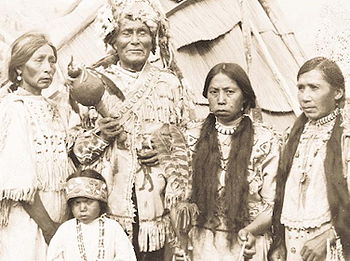- Thompson River Salish people
-
The Nlaka'pamux (pronounced [nɬeʔképmx]), commonly called "the Thompson", and also Thompson River Salish, Thompson Salish, Thompson River Indians or Thompson River people) are an indigenous First Nations/Native American people of the Interior Salish language group in southern British Columbia. Their traditional territory includes parts of the North Cascades region of Washington.
Contents
Other names
Frontier-era histories and maps transliterate the name Nlaka'pamux as Hakamaugh or Klackarpun; they were also known as the Couteau, Kootomin[1] or Knife Indians. In the dialect of the Thompson language used by the Ashcroft Indian Band, the variant Nl'akapxm is used.
The Nlaka'pamux of the Nicola Valley, who are all in the Nicola Tribal Association reserves refer to themselves Scw'exmx and speak a different dialect of the Thompson language. Together with the Spaxomin people, a branch of the Okanagan people (Syilx) who live in the upper Nicola valley and also belong to the Nicola Tribal Association, they are collectively known as the Nicola people, or Nicolas.
Religion
The Nlaka'pamux were the object of both Anglican and Roman Catholic missionary efforts in the nineteenth century, resulting in the vast majority belonging to one of the two denominations by the beginning of the Twentieth Century.[2]
Governments
The Nlaka'pamux Nation Tribal Council despite its name does not include all Nlaka'pamux people, but is one of three main tribal bodies within the region, the others being the Fraser Canyon Indian Administration and the Nicola Tribal Association. The Lytton First Nation or Lytton Band, focussed on the town of the same name, which is named Camchin or Kumsheen in the Nlaka'pamux language and is one of the largest Nlaka'pamux communities, does not belong to any of the three Tribal Association. Lower Nicola Indian band[3] is also independent of all and any Tribal affiliations and is located in Lower Nicola, British Columbia, Canada.
None of the Nlaka'pamux governments are in the British Columbia Treaty Commission process at present.[4]
Nlaka'pamux Nation Tribal Council
- Boothroyd Indian Band
- Boston Bar Indian Band
- Oregon Jack Creek Indian Band
- Spuzzum Indian Band (also a member of the Fraser Canyon Indian Administration)
Fraser Canyon Indian Administration
- Kanaka Bar Indian Band
- Skuppah Indian Band
- Spuzzum Indian Band (also a member of the Nlaka'pamux Nation Tribal Council
- Yale First Nation
Nicola Valley Tribal Association
- Shackan Indian Band(Original NTA)
- Nooaitch Indian Band(Original NTA)
- Upper Nicola Indian Band(Original NTA)(also a member of the Okanagan Nation Alliance)
- Coldwater Indian Band(Original NTA)
- Siska Indian Band
- Cook's Ferry Indian Band
- Nicomen Indian Band (Former member of the Fraser Canyon Indian Administration)
Unaffiliated
- Lytton First Nation
- Lower Nicola First Nation
- Ashcroft Indian Band
Language
The Nlaka'pamux speak an Interior Salishan language named nɬeʔkepmxcín, usually transliterated as Nlaka'pamuxtsn and known in English as the Thompson language.
See also
Notes
- ^ Kootomin is a nativized variant of the French couteau
- ^
 "Thompson River Indians". Catholic Encyclopedia. New York: Robert Appleton Company. 1913.
"Thompson River Indians". Catholic Encyclopedia. New York: Robert Appleton Company. 1913. - ^ Lower Nicola Indian band homepage
- ^ List of First Communities in BC, BC Treaty Commission
Bibliography
- Thompson River Salish Dictionary
Compiled by Laurence C. Thompson and M. Terry Thompson
- They Write Their Dreams on the Rock Forever: Rock Writings in the Stein River Valley of British Columbia (with Chris Arnett and Richard Daly
- Spuzzum: Fraser Canyon Histories, with Andrea LaForet
- Historical Atlas of British Columbia and the Pacific Northwest, Derek Hayes, Cavendish Books, Vancouver (1999) ISBN
- The Resettlement of British Columbia: Essays on Colonialism & Geographical Change, University of British Columbia Press; New Ed edition (January 1997) ISBN
- Shirley Sterling (1997). My Name is Seepeetza. Douglas and McIntyre, Inc. ISBN 0-888-99290-4.
- NLaka'pamux Language CD by Barbara Joe(2005){Editor/Producer/Technical: Dr. Shawn E. Swakum D.D}
- Shackan Stories by Jim Toodlican(2006){Editor/Producer/Technical: Shawn E. Swakum D.D}
Categories:- Nlaka'pamux
- Interior Salish
- Native American history of Washington (state)
Wikimedia Foundation. 2010.

